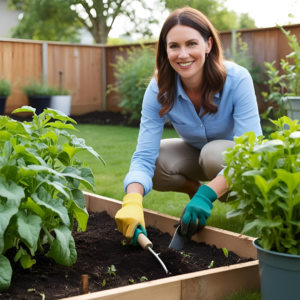Did you know that using a vertical structure can increase your crop yield by up to 50%? That’s right! By growing plants like cucumbers, tomatoes, and beans on a trellis, you not only save space but also improve air circulation and reduce pests. This simple technique can transform your trellis gardening vegetables into a thriving, organized haven.
I’ve always been amazed at how climbing plants can turn a small area into a lush, productive space. Whether it’s snap peas winding their way up a pole or melons hanging from an arch, these structures make harvesting easier and more enjoyable.
In this article, I’ll share my favorite tips for using trellises to maximize your harvest. From choosing the right plants to building a budget-friendly arch, you’ll discover how to make the most of your garden space. Let’s dive in and grow something amazing together!
Key Takeaways
- Vertical structures can boost crop yield by up to 50%.
- Improves air circulation and reduces pest issues.
- Makes harvesting easier and more efficient.
- Adds charm and organization to your garden space.
- Works well for plants like cucumbers, tomatoes, and beans.
Trellis Gardening Vegetables: Getting Started
Transforming your garden space with vertical structures is easier than you think. Whether you’re growing cucumbers, peas, or squash, a trellis can help you make the most of your area. The first step is choosing the right spot. Look for a location with plenty of sunlight and good air circulation to support healthy growth.
Preparing your garden is key. If you’re using raised beds or planting directly in the ground, ensure the soil is well-drained and nutrient-rich. Vertical planting requires different spacing than traditional methods. Plants like cucumbers and pole beans need room to climb, so rethink the spacing guidelines on seed packets.
One of the biggest advantages of vertical gardening is accessibility. When plants grow upward, watering, weeding, and harvesting become much easier. Plus, it saves a lot of space, making it ideal for smaller gardens. If you’re on a budget, DIY trellis structures can be both cost-effective and sturdy. It’s similar to how herb container gardening works.
Remember, the goal is to create a supportive structure that allows your plants to thrive. In the next sections, I’ll dive deeper into techniques and best practices to help you achieve a bountiful harvest. Let’s get started and grow something amazing!
Selecting the Perfect Trellis and Materials
Building a trellis doesn’t have to break the bank—there are plenty of budget-friendly options to explore. Whether you’re growing cucumbers, peas, or squash, the right structure can make all the difference. Let’s dive into some creative ideas and tips to help you choose the best materials for your needs.
DIY Trellis Ideas on a Budget
One of my favorite ways to save money is by repurposing materials I already have. Old ladders, wooden pallets, or even metal cattle panels can be transformed into sturdy supports for climbing plants. For example, I once turned an old wooden ladder into a trellis for my snap peas—it worked perfectly and added a rustic charm to my garden.
Here are a few other affordable ideas:
- Use bamboo poles tied together with twine for a natural look.
- Repurpose wire fencing or mesh to create a simple yet effective structure.
- Turn an old bookshelf or headboard into a unique vertical support.
Choosing Sturdy Materials for Longevity
While budget-friendly options are great, it’s also important to choose materials that will last. Metal cattle panels, for instance, are incredibly durable and can withstand harsh weather conditions. I’ve used them for my cucumbers when starting my gardening journey, and they’ve held up beautifully over the years.
Here’s what to look for when selecting materials:
- Durability: Opt for materials that resist rust, rot, or warping.
- Stability: Ensure the structure can support the weight of your plants, especially heavier varieties like melons or gourds.
- Aesthetics: Choose materials that complement your garden’s style, whether it’s rustic, modern, or whimsical.
By combining affordability with quality, you can create a trellis that not only supports your plants but also enhances your garden space for seasons to come.
Planting Techniques for Vertical Success
Vertical planting isn’t just about saving space—it also promotes healthier plants and bigger harvests. When you grow upward, you create better airflow, reduce disease risks, and make maintenance easier. But to achieve these benefits, you need to focus on two key aspects: proper spacing and effective vine training.
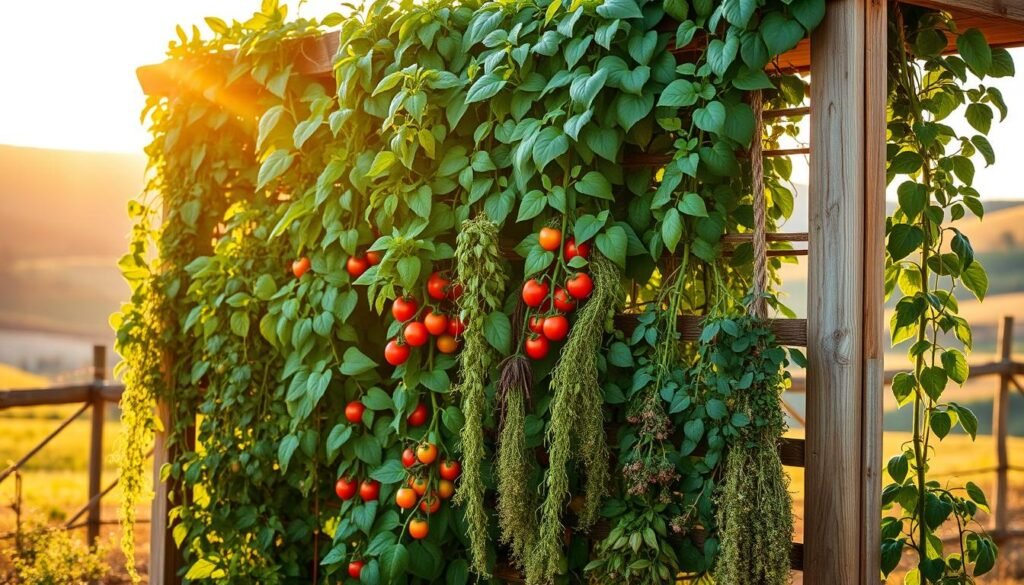
Determining the Right Plant Spacing
Spacing is crucial when growing vertically. Overcrowding can lead to poor air circulation, which increases the risk of fungal diseases. For example, cucumbers should be spaced about 6-8 inches apart on a 4-foot wide cattle panel. This allows each plant enough room to grow without competing for resources.
Here’s a quick guide for spacing common climbers:
- Cucumbers: 6-8 inches apart
- Pole beans: 4-6 inches apart
- Tomatoes: 2 feet apart
Adjusting traditional seed packet spacing is essential for vertical success. Plants need more room to spread their roots and climb effectively.
Tips for Training Climbing Vines
Training vines to climb your structure is both an art and a science. Start by gently guiding young tendrils toward the support. Use soft ties like garden twine or pantyhose to secure the vines without damaging them.
Here are some tips to make vine training easier:
- Check your plants daily during the growing season to guide new growth.
- Use a gentle touch to avoid breaking delicate stems.
- For heavy climbers like melons, provide extra support with slings made from fabric or mesh.
With the right spacing and training, your vertical garden will thrive, producing a bountiful harvest season after season. It’s also a great way to burn calories while gardening.
Growing Cucumbers and Summer Squash Up High
Growing cucumbers and summer squash vertically can transform your garden into a productive and organized space. These plants thrive when given the right support, and vertical structures make harvesting and maintenance easier. Let’s explore how to grow these favorites successfully.
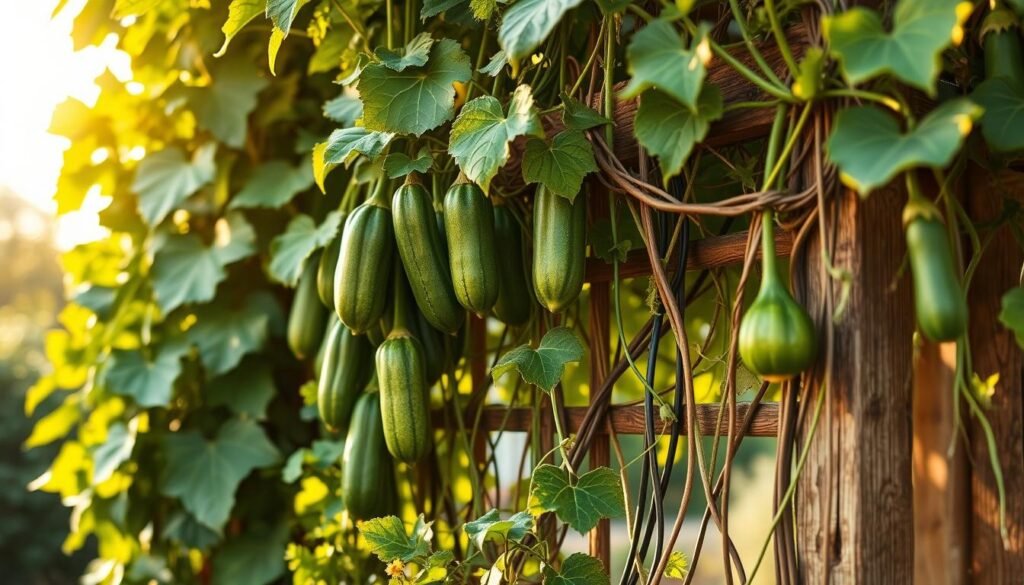
Cucumber Tips for a Bountiful Harvest
Cucumbers are natural climbers and adapt well to vertical growth. Start by spacing plants about 12 inches apart on a sturdy structure. This allows for proper airflow and prevents overcrowding. I’ve found that using soft ties to guide young vines helps them latch onto the support without damage.
Harvest cucumbers when they’re 6 to 8 inches long for the best flavor. Leaving them on the vine too long can reduce fruit production. Regular watering and fertilizing during the growing season also ensure a healthy crop.
Summer Squash: What Works and What Doesn’t
Summer squash can be more challenging to grow vertically due to their sprawling nature. However, certain varieties, like zucchini, work well with extra support. I use pantyhose or fabric slings to cradle heavier fruits and prevent them from breaking the vines.
Spacing is crucial for squash. Plant them about 2 feet apart to give each plant enough room to grow. Choosing a strong structure, like a metal arch, ensures it can handle the weight of mature squash.
By following these tips, you’ll enjoy a thriving vertical garden filled with fresh cucumbers and summer squash. It’s a rewarding way to maximize your space and grow healthy, delicious produce.
Expanding Your Vertical Garden with Beans and Peas
Beans and peas are fantastic additions to any vertical garden, offering both beauty and bounty. These climbers naturally thrive when given the right support, making them ideal for maximizing space and productivity. Whether you’re growing pole beans or bush beans, or training delicate pea tendrils, these plants can transform your garden into a lush, efficient space.
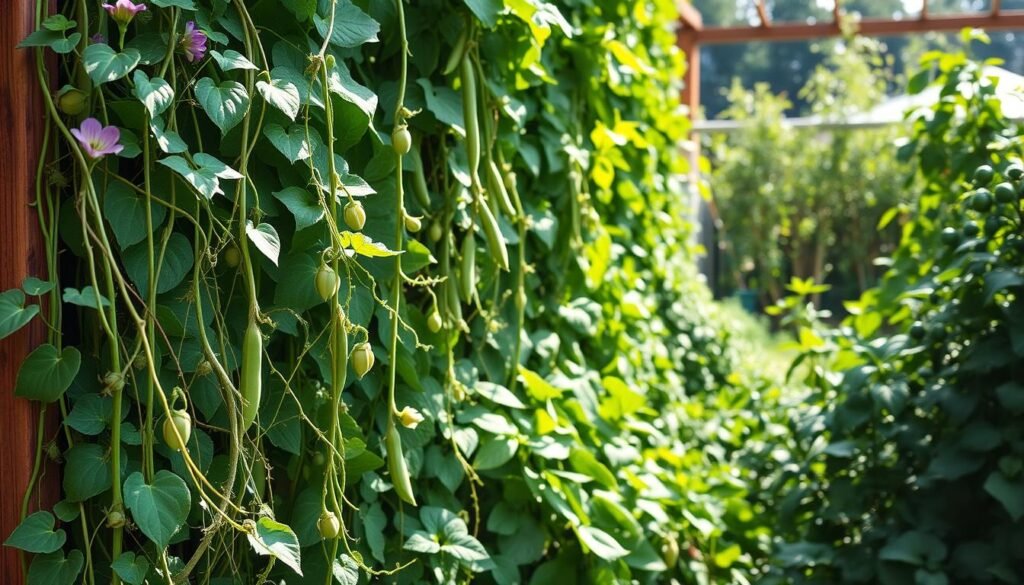
Pole Beans vs. Bush Beans
When choosing between pole beans and bush beans, it’s important to understand their differences. Pole beans are climbers, growing between 6-10 feet tall, and require sturdy support like a trellis or arch. They produce more pods over a longer season compared to bush beans, which grow only 1-2 feet tall and don’t climb.
Here’s a quick comparison:
| Feature | Pole Beans | Bush Beans |
|---|---|---|
| Height | 6-10 feet | 1-2 feet |
| Support Needed | Yes (trellis, arch) | No |
| Yield | Higher | Lower |
| Growing Season | Longer | Shorter |
For pole beans, I recommend using a metal or bamboo trellis. These materials are durable and can handle the weight of mature plants. Plant seeds about 2 inches from the base of the structure and thin seedlings to the strongest plants for optimal growth.
Tendril Training Tips for Peas
Peas are natural climbers, but a little guidance can help them thrive. They prefer to be spaced closely together, about 2 inches apart, and will use their tendrils to latch onto supports. I’ve found that using soft ties or twine can help guide young vines toward the trellis without damaging them.
Here are some tips for training peas:
- Check plants daily during the growing season to guide new growth.
- Use a gentle touch to avoid breaking delicate stems.
- For taller varieties, provide extra support with a sturdy structure like a metal arch.
Investing a little extra time in training can lead to healthier plants and higher productivity. With the right care, your vertical garden will be filled with vibrant beans and peas, offering a bountiful harvest all season long.
Seasonal Trellis Gardening: Cool, Warm, and Hot Strategies
Adjusting your garden strategy with the seasons can lead to a more productive and efficient space. By understanding the needs of cool, warm, and hot-season crops, you can maximize your harvest and keep your garden thriving year-round. Let’s start with cool-season choices for vertical planting.
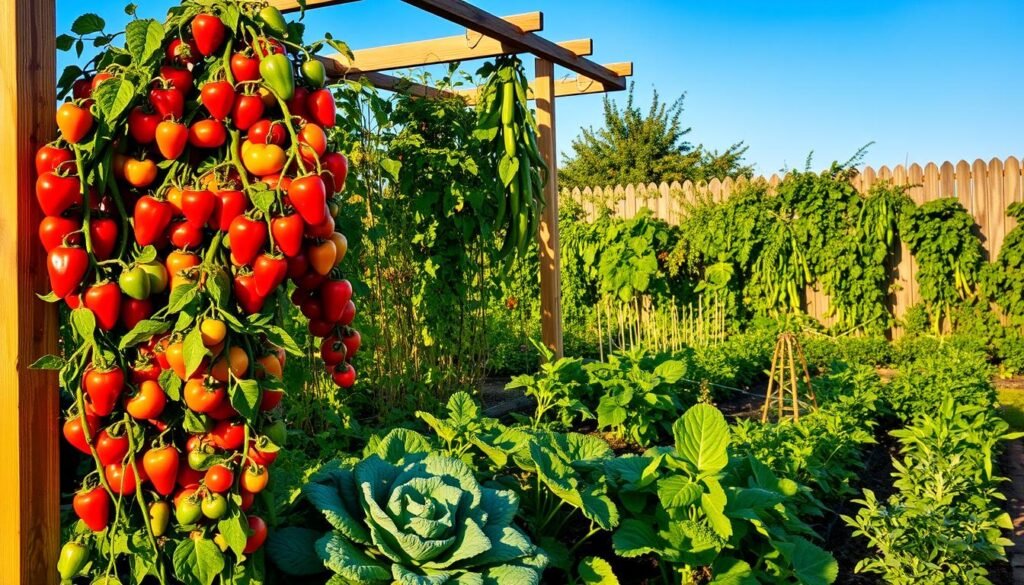
Cool Season Choices for Vertical Planting
Cool-season crops like snap peas, snow peas, and fava beans are perfect for early spring or fall. These plants thrive in cooler temperatures and can be grown vertically to save space and improve airflow. I’ve found that snap peas, in particular, are easy to train on a simple pole or arch structure.
When planting cool-season varieties, consider the following tips:
- Place your trellis in a spot that gets plenty of sunlight but is protected from strong winds.
- Use soft ties to gently guide young vines toward the support structure.
- Space plants about 2 inches apart to allow for healthy growth and airflow.
One of my favorite cool-season crops is fava beans. They grow tall and sturdy, making them ideal for vertical structures. Plus, they add nitrogen to the soil, benefiting other plants in your garden.
As temperatures rise, it’s important to adjust your trellis placement and support. Cool-season plants may need extra shade or protection during warmer days. By planning ahead, you can ensure a smooth transition between seasons and keep your garden productive.
With the right approach, cool-season vertical planting can be a rewarding way to extend your growing season and enjoy fresh produce even in cooler weather.
Enhancing Air Circulation and Plant Health Vertically
Improving air circulation in your garden can significantly boost plant health and productivity. When plants grow vertically, their foliage stays off the ground, allowing leaves to dry faster after rain. This reduces humidity and lowers the risk of fungal diseases like powdery mildew.
One of the biggest advantages of vertical planting is the improved airflow around each plant. When leaves are spaced properly, they receive more sunlight and dry quicker, which keeps them healthier. This is especially important for crops like tomatoes and cucumbers, which are prone to diseases in damp conditions.
“Vertical gardening keeps foliage off the ground, leading to faster drying of leaves after rain, reducing humidity and the risk of fungal diseases.”
Maximizing Airflow for Healthier Plants
To maximize airflow, it’s essential to space plants appropriately on your structure. Overcrowding can block air movement and create a breeding ground for pests and diseases. For example, cucumbers should be spaced 6-8 inches apart, while pole beans need 4-6 inches.
Here’s a quick guide to spacing common climbers:
| Plant | Spacing |
|---|---|
| Cucumbers | 6-8 inches |
| Pole Beans | 4-6 inches |
| Tomatoes | 2 feet |
Reduced contact with soil also helps keep vegetables healthier. When fruits like tomatoes and cucumbers are elevated, they’re less likely to rot or attract pests. This makes harvesting easier and ensures a cleaner, more bountiful crop.
By focusing on proper spacing and support, you can create a garden that thrives with natural air circulation. This simple step leads to stronger plants and a more productive growing season.
Creative Ideas for DIY Trellis Structures
Unleash your creativity by crafting unique trellis structures that blend functionality with style. Building your own supports not only saves money but also allows you to tailor designs to your garden’s needs. Whether you’re growing cucumbers, peas, or beans, DIY trellises can be both practical and beautiful.
Incorporating Recycled Materials
One of the best ways to create a budget-friendly trellis is by using recycled materials. Old ladders, wooden pallets, or even metal fencing can be transformed into sturdy supports. For example, I’ve turned an old bookshelf into a trellis for my snap peas—it added a rustic touch to my garden while keeping costs low.
Here are some creative ideas to get you started:
- Use bamboo poles tied together with twine for a natural look.
- Repurpose wire mesh or cattle panels for a durable structure.
- Turn an old headboard or ladder into a unique vertical support.
Personalizing Your Garden Aesthetics
Your trellis doesn’t have to be just functional—it can also be a decorative focal point. By choosing materials that match your garden’s style, you can create a cohesive and visually appealing space. For instance, I’ve used reclaimed wood to build an arch that complements my cottage-style garden.
Here’s how to personalize your trellis:
- Paint or stain wooden structures to match your garden’s color scheme.
- Add climbing flowers like morning glories to enhance the design.
- Experiment with shapes, such as arches or obelisks, to create visual interest.
By combining practicality with creativity, you can design trellises that not only support your plants but also elevate your garden’s aesthetic. It’s a rewarding way to make your space truly your own.
Maintenance and Harvest Tips for Vertical Gardens
Maintaining a vertical garden doesn’t have to be overwhelming—here’s how to keep it thriving. By focusing on efficient watering, fertilizing, and regular care, you can ensure your plants stay healthy and productive throughout the growing season. Let’s dive into some practical tips to make maintenance easier and more effective.
Watering and Fertilizing Techniques
Watering vertically grown plants requires a bit of strategy. Aim to deliver moisture directly to the roots without wetting the foliage. I’ve found that drip irrigation systems work wonders for this. They ensure consistent hydration while reducing the risk of fungal diseases.
When it comes to fertilizing, choose a balanced formula that supports healthy growth. I prefer using slow-release fertilizers applied every 4-6 weeks. This method saves time and ensures nutrients are available when plants need them most.
Simplifying Maintenance
One of the biggest advantages of vertical systems is reduced maintenance. With plants growing upward, tasks like weeding and harvesting become much easier. I recommend checking your garden weekly to monitor growth and address any issues early.
Here are a few ways to streamline care:
- Use soft ties to secure vines and prevent damage.
- Prune regularly to promote airflow and reduce overcrowding.
- Harvest fruits like cucumbers and beans as soon as they’re ripe to encourage more production.
Monitoring Plant Health
Keeping an eye on your plants is crucial for a successful harvest. Look for signs of pests or disease, such as yellowing leaves or unusual spots. Early intervention can prevent bigger problems down the line.
Adjust your care routine based on weather conditions. During hot summer days, increase watering frequency to prevent stress. In cooler seasons, reduce watering and focus on protecting plants from frost.
By following these tips, you’ll enjoy a thriving vertical garden that’s both productive and beautiful. It’s a rewarding way to maximize your space and grow healthy, delicious produce.
Grow Your Trellis Garden Today
With the right support, your garden can flourish in ways you never imagined. Vertical systems not only save space but also improve plant health and simplify maintenance. From DIY structures to seasonal strategies, there’s a variety of ways to make your garden thrive.
Experimenting with vertical planting can lead to a bountiful harvest and a beautifully organized space. Whether it’s pole beans climbing an arch or tomatoes supported by a sturdy structure, the possibilities are endless. I’ve found that elevating plants enhances airflow and keeps fruits cleaner, making harvesting a breeze.
As you plan your next growing season, consider incorporating vertical techniques. It’s a rewarding way to maximize your garden’s potential. I’d love to hear about your experiences—share your stories and let’s grow something amazing together!
FAQ
What are the best plants to grow on a trellis?
I’ve found that cucumbers, summer squash, pole beans, and peas thrive when grown vertically. They climb naturally and save a lot of space in my garden.
How do I choose the right trellis material?
I recommend using sturdy materials like metal or wood for durability. For a budget-friendly option, I’ve had success with recycled items like old fencing or bamboo poles.
How much space should I leave between plants on a trellis?
I usually space my plants about 12 inches apart to ensure they have room to grow and receive proper air circulation. This helps prevent overcrowding and disease.
Can I grow tomatoes on a trellis?
Absolutely! I’ve grown tomatoes vertically by using a sturdy structure like an arch or fence. Just make sure to tie the vines gently as they grow to support their weight.
How do I train climbing vines to grow upward?
I guide the tendrils of plants like peas and beans onto the trellis as they grow. For heavier vines like squash, I use soft ties to secure them to the structure.
What’s the best way to maximize airflow in a vertical garden?
I make sure to space my plants properly and avoid overcrowding. This allows air to circulate freely, reducing the risk of mold or mildew.
Can I use a trellis for cool-season plants too?
Yes! I’ve successfully grown cool-season crops like snap peas and malabar spinach on a trellis. They thrive in cooler weather and add variety to my garden.
How often should I water my vertical garden?
I check the soil daily and water when the top inch feels dry. Vertical gardens can dry out faster, so consistent watering is key to healthy growth.
Are there creative DIY trellis ideas I can try?
Definitely! I’ve used old ladders, pallets, and even repurposed metal grids to create unique trellises. It’s a fun way to personalize my garden space.
When is the best time to harvest from a vertical garden?
I harvest cucumbers and beans when they’re firm and snap easily. For squash, I pick them while they’re still small and tender for the best flavor.

